- Clone
- A16089A (See other available formats)
- Regulatory Status
- RUO
- Other Names
- Signal Transducer and Activator of Transcription 3, Acute-Phase Response Factor, APRF, ADMIO, HIES
- Isotype
- Mouse IgG1, κ
- Ave. Rating
- Submit a Review
- Product Citations
- publications
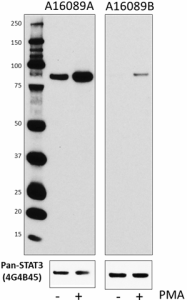
-

Total cell lysates (15 µg total protein) from Jurkat cells serum starved and untreated (-) or stimulated with 160 nM PMA for 15 minutes (+) were resolved by 4-20% Tris-glycine gel electrophoresis, transferred to a nitrocellulose membrane, and probed with 2.0 µg/mL (1:250 dilution) purified anti-STAT3 Phospho (Ser727) antibody (clones A16089A and A16089B) overnight at 4°C. Proteins were visualized by chemiluminescence detection using HRP goat anti-mouse IgG antibody (Cat. No. 405306) at a 1:3000 dilution. Purified anti-STAT3 pan antibody (clone 4G4B45) (Cat. No. 678002) was used as a pan STAT3 loading control at 1.0 µg/mL (1:500 dilution). Lane M: Molecular weight marker. -

Total cell lysates (15 µg total protein) from HeLa and NIH/3T3 cells serum starved and untreated (-) or stimulated with 100 ng/mL recombinant human IL-6 (Cat. No. 715104) or recombinant mouse IL-6 (Cat. No. 715202), respectively for 30 minutes (+) were resolved by 4-12% Bis-Tris gel electrophoresis, transferred to a PVDF membrane, and probed with 1.0 µg/mL (1:2500 dilution) purified anti-STAT3 Phospho (Ser727) antibody (clones A16089A and A16089B) overnight at 4°C. Proteins were visualized by chemiluminescence detection using HRP goat anti-mouse IgG Antibody (Cat. No. 405306) at a 1:3000 dilution. Lane M: Molecular weight marker. Equal protein loading was confirmed using Direct-Blot™ HRP anti-GAPDH Antibody (Cat. No. 607904). -

Total cell lysates (15 µg total protein) from HeLa and cells serum starved and untreated (-) or stimulated with 100 ng/mL recombinant human IL-6 for 30 minutes were resolved by 4-12% Bis-Tris gel electrophoresis, transferred to a PVDF membrane, and probed with 1.0 µg/mL (1:2500 dilution) purified anti-STAT3 Phospho (Ser727) antibody (clones A16089A and A16089B) overnight at 4°C. Proteins were visualized by chemiluminescence detection using HRP goat anti-mouse IgG antibody (Cat. No. 405306) at a 1:3000 dilution. To demonstrate phospho-specificity of the clone, membranes were either untreated or pre-treated with lambda protein phosphatase. Equal protein loading was confirmed using Direct-Blot™ HRP anti-GAPDH Antibody (Cat. No. 607904). Lane M: Molecular weight marker. -

HeLa cells were fixed with 4% paraformaldehyde for 10 minutes, permeabilized with Triton X-100 for 10 minutes, and blocked with 5% FBS for 60 minutes. Cells were then intracellularly stained with a 1:200 dilution (2.5 µg/mL) of purified anti-STAT3 Phospho (Ser727) (clones A16089A and A16089B) for two hours at room temperature, followed by incubation with Alexa Fluor® 594 goat anti-mouse IgG (Cat. No. 405326) at 2.0 µg/mL. To confirm phospho-specificity of each clone, fixed cells pre-treated with lambda protein phosphatase (LPP) prior to staining were included as a control. Nuclei were counterstained with DAPI, and the image was captured with a 60X objective.
| Cat # | Size | Price | Quantity Check Availability | Save | ||
|---|---|---|---|---|---|---|
| 669501 | 25 µg | $112 | ||||
| 669502 | 100 µg | $265 | ||||
The STAT3 transcription factor is an important signaling molecule for many cytokines and growth factor receptors and is required for murine fetal development. STAT3 is a member of the STAT (signal transducer and activator of transcription) protein family that is phosphorylated in response to a cytokine receptor-associated kinase activity. STAT3 is activated by phosphorylation at Tyr705, which induces dimerization, nuclear translocation, and DNA binding. Transcriptional activation was reported to be regulated by phosphorylation at Ser727 through MAPK and mTOR pathways.
STAT3 forms both homo- and heterotrimers and is involved in the activation of genes required for cell growth and apoptosis. STAT3 is also involved in gp130 signaling and binds to IL-6 response elements in various acute phase protein promoters. STAT3 is phosphorylated by signaling from IFNs, EGF, FGF, IL-5, HGF, LIF, and BMP-2. STAT3 activity is inhibited by PIAS3 and GRIM-19 and can also be regulated by the Rac1 protein.
Product Details
- Verified Reactivity
- Human, Mouse
- Antibody Type
- Monoclonal
- Host Species
- Mouse
- Immunogen
- Synthetic human STAT3 peptide phosphorylated at serine 727
- Formulation
- Phosphate-buffered solution, pH 7.2, containing 0.09% sodium azide
- Preparation
- The antibody was purified by affinity chromatography.
- Concentration
- 0.5 mg/mL
- Storage & Handling
- The antibody solution should be stored undiluted between 2°C and 8°C.
- Application
-
WB - Quality tested
ICC - Verified - Recommended Usage
-
Each lot of this antibody is quality control tested by western blotting. For western blotting, the suggested use of this reagent is 1.0 - 2.0 µg/mL. For immunocytochemistry, a concentration range of 1.0 - 5.0 μg/mL is recommended. It is recommended that the reagent be titrated for optimal performance for each application.
- Application Notes
-
Clones A16089A and A16089B are both specific for STAT3 phosphorylated at serine 727, but performed differently for different applications tested:
Both clones displayed strong specificity and selectivity for WB, but clone A16089A displayed a considerably stronger affinity for the target compared to A16089B
Both clones performed well for ICC, though clone A16089A displayed mild extranuclear staining
A16089B performed well for ChIP, A16089A failed ChIP application testing - RRID
-
AB_2892483 (BioLegend Cat. No. 669501)
AB_2892483 (BioLegend Cat. No. 669502)
Antigen Details
- Structure
- STAT3 is a 770 amino acid protein with a predicted molecular weight of 88 kDa. It consists of a DNA binding domain, a SH2 domain, a regulatory tyrosine responsible for binding of SH2 domain, and a C-terminal transactivation domain.
- Distribution
-
Cytosol and nucleus/Ubiquitously expressed
- Function
- Transcription factor
- Antigen References
-
- Akira S, et al. 1994. Cell. 77:63-71.
- Zhang X, et al. 1995. Science. 267:1990-4.
- Sanchez-Margalet V & Martin-Romero C. 2001. Cell Immunol. 211:30-6.
- Simon AR, et al. 2000. Science. 290:144-7.
- Hoey T & Grusby MJ. 1999. Adv Immunol. 71:145-62.
- Gene ID
- 6774 View all products for this Gene ID
- UniProt
- View information about STAT3 Phospho Ser727 on UniProt.org
Related Pages & Pathways
Pages
Other Formats
View All STAT3 Reagents Request Custom Conjugation| Description | Clone | Applications |
|---|---|---|
| Purified anti-STAT3 Phospho (Ser727) | A16089A | WB,ICC |
Compare Data Across All Formats
This data display is provided for general comparisons between formats.
Your actual data may vary due to variations in samples, target cells, instruments and their settings, staining conditions, and other factors.
If you need assistance with selecting the best format contact our expert technical support team.
 Login/Register
Login/Register 




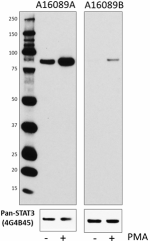
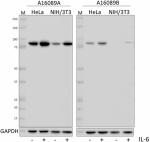
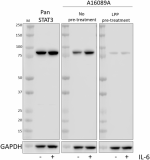
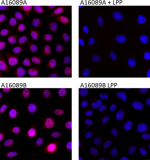



Follow Us